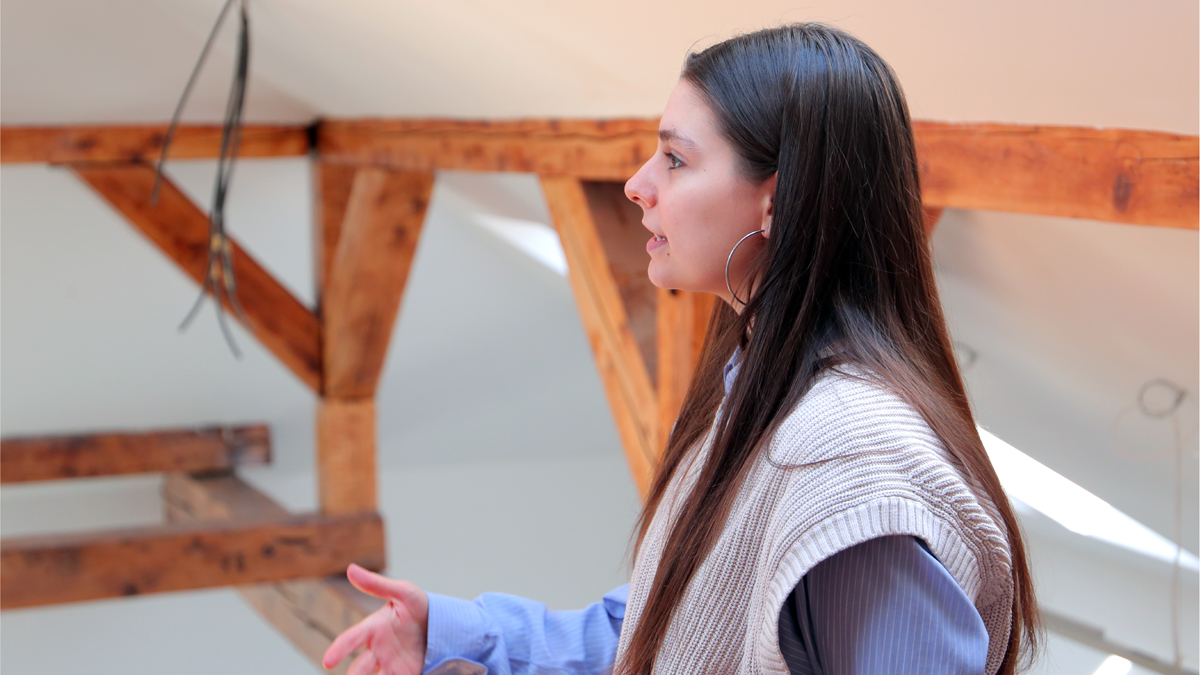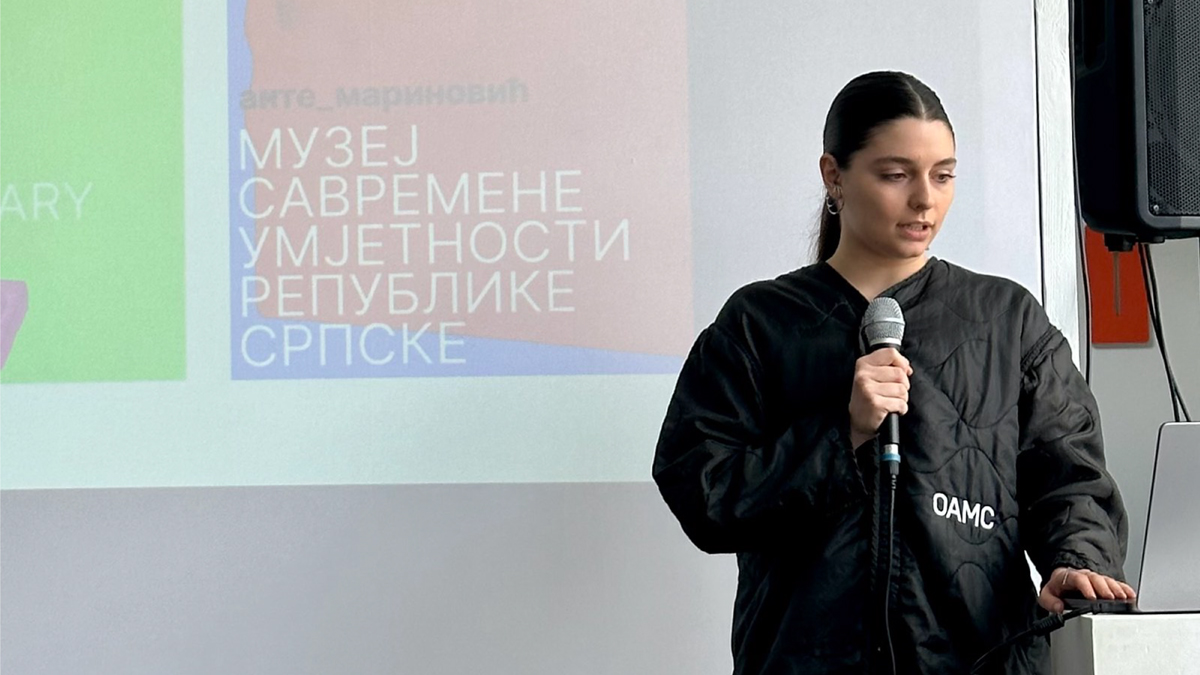‘To be completely honest, the idea of authorship in teamwork is like an uninvited awakening of ego or vanity, when it comes from one of the members. The most central element of design is functionality, the moment where it is separated from fine arts by this capacity to generate excitement with how a design solution is applied,’ Sonja Jovanović.
 Hi Sonja! We’re truly grateful for squeezing us into your packed agenda, all while managing to spare some moments to delve into your ReCulture project journey. I would start by asking is this the first time you have experienced working with a cultural institution?
Hi Sonja! We’re truly grateful for squeezing us into your packed agenda, all while managing to spare some moments to delve into your ReCulture project journey. I would start by asking is this the first time you have experienced working with a cultural institution?
Hello ReCulture! Hello everyone! Yes! In designer capacity – yes.
How challenging was it to work within a team? After this experience, what do you think are the challenges and advantages compared to working independently with a client?
The main advantage, and this is likely universal to any, not just design-related team work, are different points of view and strengths of each individual. Where one member might feel insecure, insufficient or simply unexcited, others might be very successful, experienced and motivated to cover. This is very time efficient and also good for the energy inside the team. The biggest challenge is a possibility of a misunderstanding and the lack of ability to cover some parts of the process that is usually covered by another member. Everybody can get too comfortable in their role and find it difficult to switch to another. So I guess that the ‘work division’ advantage is also the weak point of team work.
What contribution to the development of the institution’s new identity are you most proud of?
Mostly, I am proud of offering structure and functionality to the very expressive, intuitive and bold solutions that were initiated by Luka. And of my interpretational capacity for the concept that we offered, and the narrative built around it.
How much can you express yourself creatively in the final solution when you work within a team?
To be completely honest, the idea of authorship in teamwork is like an uninvited awakening of ego or vanity, when it comes from one of the members. The most central element of design is functionality, the moment where it is separated from fine arts by this capacity to generate excitement with how a design solution is applied. Therefore, it should never matter who the best idea in team comes from, and the best idea(s) should always be the one(s) to develop. And if an individual can’t relate to the team’s work as their own and without frustration, they might be in the wrong team.
Has the project enabled you to further shape your design language?
Not exactly, but it certainly has offered some life lessons and helped me get to know myself better. Firstly and from a professional perspective, identifying my strengths within the process – it motivated me to maybe find out which positions rely on the things I’m good at and gravitate towards that. Secondly and generally speaking, it clearly displayed that the timeline for any project can also be too long, not only too short – and that both extremes make the project suffer.
In what aspect was the visit to the institutions useful for your research process? Do you think this should be an integral part of the practice in working with clients?
In every aspect. Personally, I am tired of generic solutions that are produced and acceptable in this moment of hyperproduction of anything visual, which is a current modus operandi. Things, projects and solutions that are personal, one of a kind, made to order, are much more interesting and exciting. And for that, we need to get well acquainted with one another.
After your experience with this project, and other work experiences, explain the difference between working with cultural institutions and clients that promote commercial content (if you have experience with them).
This is a hard comparison, not as much due to the commercial vs. cultural client situation, but the entire intention, format and duration of this particular project, unlike anything else I’ve ever done. From my point of view, the tools with which we shape the solution and lab test its success are similar for any kind of client, only the parameters differ. For me, the main difference between this project and a commercial project would be the fact that I protected myself less, I’ve shown as many options as I could think of without the smart reduction and curation of the content, and really behaved as if everything done is common ownership and can be dissected by anyone in the team.
What of the experience gained during this project would you apply in your further independent work or work with future clients?
Unless you understand exactly what you’re getting into and have previous experience, never sign a 3-year contract. We simply do not live in the time when that is normal or in line with life dynamics, especially for creative industries, where creative directors or other high level professionals of major brands and houses are often getting in and out within a year. For your own and for the project’s sake.
What makes the cultural institution you worked on in this project unique? How does it meet the needs of a young audience?
First of all, MCARS is a noble institution that truly exists for its audience and tries to communicate any way they can think of. Unlike many cultural institutions that are satisfied to stay the same behind their closed doors, this team is working hard to catch the moment of contemporary and bring it to this, comparatively small, but growing environment. This effort is contributed by the ReCulture project, but also by the big undergoing reconstruction that is aimed at establishing this institution as an academic and creative hub for the widest audience possible: from professionals and artists to anyone who randomly enters the museum.
 Why do you think this project is important for the cultural institution you collaborated with?
Why do you think this project is important for the cultural institution you collaborated with?
Visual identity of an institution is the first, the most visible and ever present element in their communication with the world. That first impression lasts, and the visibility makes it susceptible to critique, analysis and opinions from anyone who comes across. It also speaks of professionalism and the institution’s awareness of the current moment, which is essential for an institution whose very name includes the words such as contemporary and art. In a visual sense, there is no room for relics of the past that didn’t age well.
What is the strongest impression that the project has left on you?
Two (main) things. First, there are amazing people working in culture. Not only people who do not seek a more lucrative position, not only people who find it convenient and easy, but individuals who are highly motivated, who feel and transmit the respect and the excitement around aspects of the cultural discipline their institution houses. And second, the project itself took too long to complete, and whichever technical reasons were the cause of this, I feel it did damage the process. Motivation of somebody contracted from the outside, as we all were, is not a reliable thing, and I feel we would have offered even better solutions had our activities been packed in up to six months.
Which cultural institutions in the region, and which ones outside the region, do you consider to be examples of best practice?
Museum of Apoxyomenos in Mali Lošinj (Croatia) is a great example of both the museum practice and the identity for an institution.
Who would you suggest as a mentor for an upcoming project?
I would need to know more about the project. One of the people who always asks the right questions, no matter the scale, is Pavle Stamenović, an architect and my mentor during architecture studies.
Thank you for making time to speak with me today, Sonja. I am convinced that our readers will learn a lot from this interview!